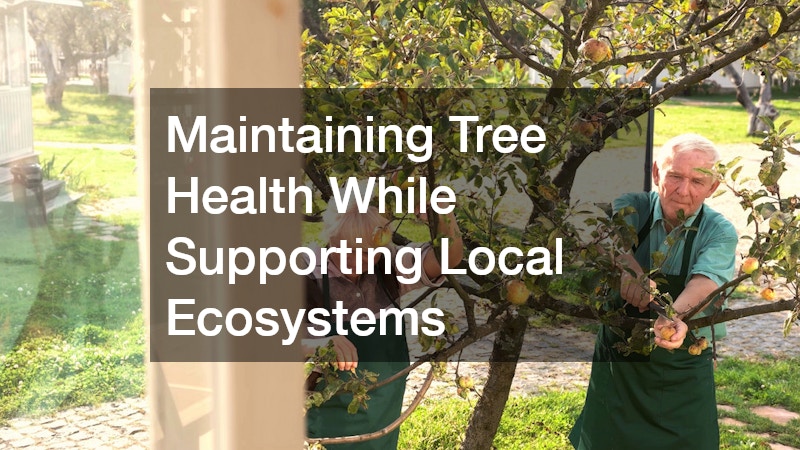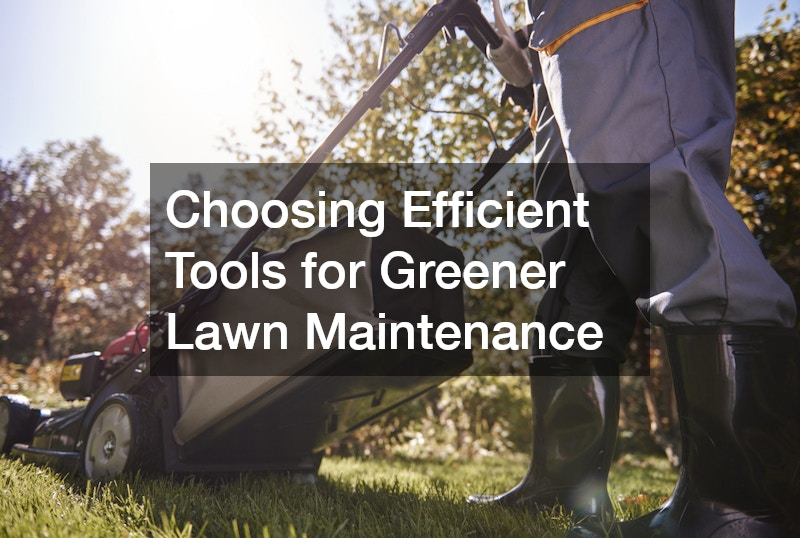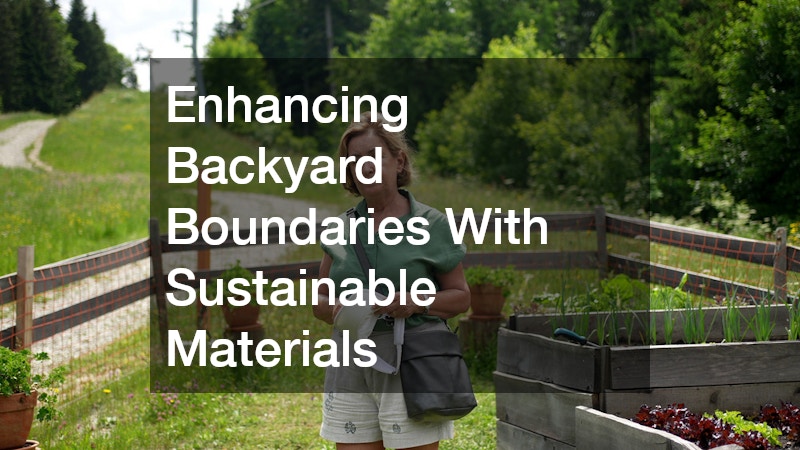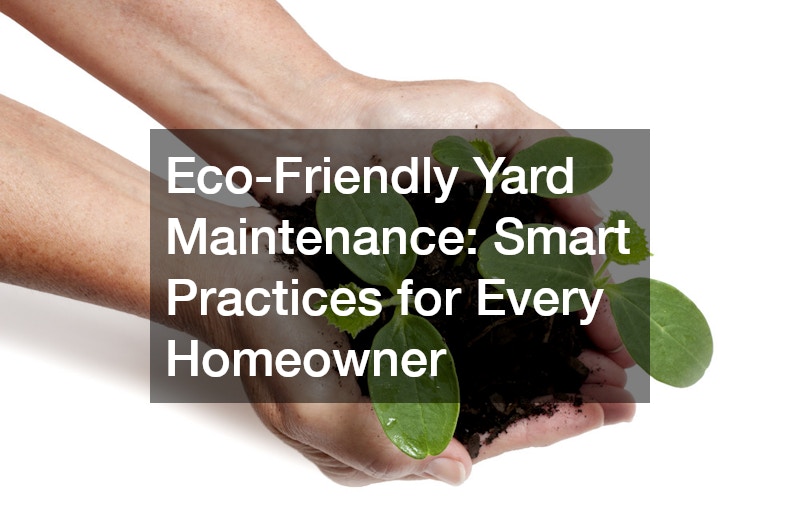Homeowners across the country are becoming increasingly aware of the impact their outdoor maintenance habits have on the environment. From the type of grass grown to the tools used for upkeep, every choice influences soil health, water conservation, and local biodiversity. Sustainable yard care isn’t just about reducing waste—it’s about creating a thriving outdoor environment that supports both people and nature. With a few mindful changes, homeowners can maintain beautiful, functional spaces while protecting the planet.
Promoting Healthy Lawns Through Sustainable Growth

Lawn care often serves as the foundation of backyard maintenance, and many eco-conscious homeowners are looking for ways to grow lush, green grass without relying on heavy irrigation or chemical treatments. Sustainable lawn establishment starts with understanding how soil, sunlight, and plant choice interact. Instead of using water-intensive methods, homeowners can promote healthy grass growth through soil enrichment, mulching, and planting native varieties that require minimal maintenance.
For homeowners planning to start fresh or rejuvenate worn-out patches of lawn, hydroseeding services offer an environmentally responsible option. This process combines grass seed, mulch, and fertilizer in a water-based slurry that’s sprayed evenly over prepared soil. Not only does it use less water than traditional seeding, but it also reduces soil erosion and improves seed germination.
To maintain the lawn after it’s established, consistent yet eco-friendly practices are key. Homeowners can aerate periodically, compost clippings instead of discarding them, and water deeply but infrequently to encourage robust root systems. These habits reduce runoff, prevent soil compaction, and limit dependence on synthetic fertilizers. The result is a vibrant, low-impact landscape that remains healthy throughout the changing seasons.
Nurturing Trees for Long-Term Environmental Benefits
Trees are an essential part of any eco-friendly yard, offering shade, improving air quality, and providing homes for local wildlife. Sustainable maintenance begins with understanding the needs of each species and ensuring that they receive proper water, sunlight, and nutrients. Regular inspection for signs of stress, pests, or disease allows homeowners to intervene early and maintain the balance of their backyard ecosystem. Thoughtful pruning and watering habits not only keep trees healthy but also strengthen their resilience against drought and climate changes.
Professional tree care goes beyond basic maintenance by focusing on long-term vitality. Certified arborists use environmentally safe practices to manage pests, encourage healthy root systems, and ensure trees grow naturally without damaging nearby plants or structures. This type of targeted attention minimizes the need for chemical treatments and unnecessary trimming. A sustainable tree management plan enhances the beauty of a yard while safeguarding one of its most vital ecological assets.
Incorporating trees into a sustainable landscape also contributes to greater environmental balance. Their canopies moderate temperature extremes, reducing reliance on air-conditioning in warmer months. Leaf litter provides natural mulch that nourishes the soil, while deep roots stabilize ground layers and prevent erosion. Over time, the combination of thoughtful planning and dedicated maintenance helps homeowners create thriving mini-ecosystems right in their own backyards.
Maintaining Tree Health While Supporting Local Ecosystems

Maintaining a diverse collection of trees enhances both the aesthetic appeal and ecological value of a backyard. Each tree species plays a role in creating a balanced environment—some attract pollinators, while others provide natural shade that reduces the need for artificial cooling. Eco-conscious homeowners often focus on planting native trees that thrive in their local climate, supporting local biodiversity and reducing the need for excess watering or fertilizers.
Hiring a professional tree service can make all the difference in ensuring sustainable management practices. Skilled technicians use precision pruning methods that prevent overcutting and protect the tree’s health. They also handle dead or decaying branches responsibly, turning them into mulch or compost rather than adding to landfill waste. By maintaining trees in a way that complements local ecosystems, homeowners can enjoy thriving, naturally balanced landscapes that contribute positively to their environment.
Beyond the practical benefits, eco-friendly tree management supports neighborhood ecology. Healthy, mature trees absorb pollutants and provide crucial habitat for birds and insects that regulate pest populations. This creates a ripple effect, improving overall ecosystem health and reducing the need for external intervention. When each household practices sustainable tree maintenance, entire communities can experience cleaner air, reduced heat, and improved biodiversity.
Improving Safety and Sustainability With Regular Tree Upkeep
Sustainable maintenance isn’t only about keeping plants healthy—it’s also about maintaining safety and preventing property damage. Overgrown branches can threaten roofs, power lines, and nearby structures, while dense canopies may block essential sunlight from reaching the plants below. Regular trimming encourages even growth and helps the entire landscape function as a connected system. When done thoughtfully, it also improves airflow, reduces pest risks, and supports stronger, more stable trees.
Using a local tree trimming professional ensures that maintenance aligns with both environmental and safety standards. Local experts are familiar with native species, climate patterns, and proper pruning seasons, reducing the likelihood of harm to the ecosystem. They can also identify opportunities to recycle trimmed materials for compost or mulch, keeping organic matter within the yard’s natural cycle. This approach maintains safety while promoting the long-term health and sustainability of the property’s trees.
Frequent but minimal intervention is the most sustainable trimming strategy. Light annual pruning allows trees to heal naturally and maintain their energy balance. It also provides homeowners with ongoing opportunities to assess the health of their trees and address small problems before they become serious. Through these regular yet measured efforts, property owners maintain both ecological balance and structural safety.
Choosing Efficient Tools for Greener Lawn Maintenance

The tools used for yard care play a significant role in determining the environmental footprint of maintenance routines. Gas-powered machines emit pollutants and contribute to noise pollution, while energy-efficient tools reduce both. Battery-powered or manual equipment, when maintained properly, provides the same results without harming air quality. Eco-conscious homeowners often choose tools designed for minimal energy use and longevity, cutting down on waste and carbon emissions.
When selecting a lawn mower, opting for an electric or reel model can significantly reduce fossil fuel use. Electric mowers operate quietly and efficiently, making them ideal for suburban neighborhoods focused on sustainability. Regular maintenance—like sharpening blades and cleaning filters—further enhances energy efficiency. By pairing eco-friendly tools with responsible mowing practices, homeowners can maintain lush lawns while reducing their carbon footprint and supporting a cleaner environment.
Additionally, mowing habits themselves can influence sustainability. Cutting grass too short can weaken roots and increase water consumption, while leaving clippings on the lawn naturally replenishes nutrients. Adjusting mowing schedules based on growth rates rather than fixed routines minimizes unnecessary energy use. These thoughtful adjustments make the difference between routine yard care and a truly sustainable maintenance strategy.
Preparing the Ground Responsibly for Landscape Projects
Ground preparation is a crucial step in any major landscaping or backyard renovation project. Digging without proper planning can disrupt soil structure, harm root systems, and lead to erosion or water runoff issues. Sustainable ground preparation involves understanding the land’s natural slope, drainage patterns, and vegetation. By working with the environment rather than against it, homeowners can ensure that new projects enhance rather than degrade their property’s ecosystem.
Partnering with a local excavating service that prioritizes eco-friendly practices ensures responsible soil handling. Such professionals use methods that limit compaction, manage waste appropriately, and avoid unnecessary damage to existing plant life. They also help with efficient grading that supports natural water flow, reducing erosion risks.
Homeowners can further support sustainability by choosing natural or permeable materials for hardscaping. Using gravel, stone, or permeable pavers allows rainwater to soak back into the soil instead of causing runoff. Adding native plants along excavated areas helps stabilize soil and restore balance after major work. Combining these efforts results in a backyard that’s functional, durable, and ecologically sound.
Enhancing Backyard Boundaries With Sustainable Materials

Boundaries define the layout of a yard, but they also play a role in environmental sustainability. Choosing the right materials can mean the difference between a wasteful installation and one that complements nature. Eco-friendly fencing materials—like bamboo, recycled composite, or sustainably harvested wood—help reduce the demand for virgin resources. Proper placement can even enhance energy efficiency by acting as a windbreak, protecting gardens and outdoor spaces from erosion or excessive exposure.
Modern fencing options cater to both durability and environmental responsibility. Homeowners can select products that require minimal chemical treatment and offer long lifespans, reducing replacement frequency. When installed properly, these materials not only provide privacy and structure but also support local sustainability efforts. With careful selection and installation, homeowners can create attractive, eco-friendly barriers that align with their green living goals.
Maintenance practices also play an important role in keeping fences sustainable. Applying non-toxic sealants, performing regular inspections, and repairing damage promptly prevent wasteful replacements. Recycling or repurposing old panels and posts can further reduce environmental impact. A well-maintained, sustainably sourced fence becomes a long-lasting part of the landscape rather than a recurring environmental cost.
Partnering With Experts for Eco-Conscious Installations
Installing outdoor structures requires more than just good materials—it calls for precision, safety, and an understanding of environmental impact. Eco-conscious homeowners benefit from choosing professionals who consider soil health, drainage, and surrounding plant life before beginning any project. Sustainable installation minimizes disturbance to existing ecosystems, reduces waste, and ensures that outdoor features blend seamlessly into the landscape.
Working with a local fence installer who specializes in sustainable techniques helps homeowners achieve these goals efficiently. Local experts are familiar with regional soil conditions and can recommend the most suitable materials to withstand the climate. They also prioritize responsible disposal or recycling of old fencing materials, ensuring minimal environmental disruption.
Beyond technical skill, hiring local professionals strengthens the community’s green economy. Supporting nearby businesses reduces transportation emissions and encourages regional sustainability initiatives. It also fosters collaboration between homeowners and contractors who share the same environmental values—creating a lasting partnership rooted in eco-friendly goals.
Protecting Underground Resources Before Outdoor Work
Before starting any digging or major landscaping project, it’s essential to know what lies beneath the surface. Underground utilities such as water, gas, or electrical lines can pose significant safety and environmental risks if disturbed. Sustainable yard maintenance includes careful planning to avoid damaging these systems. By identifying underground infrastructure, homeowners protect not only their property but also their local environment from potential contamination or disruption.
Contacting a utility locator company before any excavation ensures that underground utilities are mapped accurately. These professionals use specialized equipment to detect and mark buried lines, preventing accidental damage during construction or planting. This proactive step supports both safety and sustainability by reducing the risk of leaks, power outages, or soil contamination.
Taking this step early in the project also improves efficiency and reduces costs. Clear mapping allows landscapers and contractors to plan work around critical areas, minimizing unnecessary digging. It also ensures compliance with local regulations and safety standards. This simple yet essential measure sets the foundation for environmentally sound backyard projects.
Reducing Pests While Preserving Backyard Biodiversity
Maintaining a healthy, eco-friendly yard involves managing pests in a way that doesn’t harm beneficial insects or wildlife. Conventional pesticides can disrupt ecosystems, poison pollinators, and contaminate soil and water. A sustainable approach focuses on prevention—eliminating standing water, improving drainage, and encouraging natural predators like bats and dragonflies. These strategies create a balanced environment where nature maintains its own equilibrium.
Modern mosquito control methods emphasize safety and environmental balance. Instead of chemical sprays, many homeowners use organic repellents, citronella plants, or eco-friendly traps to manage insect populations. Some even install small ponds with fish species that feed on mosquito larvae. These approaches effectively reduce pests while maintaining biodiversity, allowing families to enjoy their outdoor spaces without compromising ecological health.
A holistic pest management strategy integrates multiple sustainable techniques. Maintaining airflow through trimming, using native plants that deter insects, and installing birdhouses to attract natural predators all work together to maintain balance. By focusing on prevention rather than eradication, homeowners protect both the beauty and ecological integrity of their outdoor spaces.
Eco-friendly yard maintenance represents a shift from short-term aesthetic goals to long-term ecological stewardship. Each decision—from how you mow your lawn to how you protect underground utilities—contributes to the health of your local environment. Thoughtful care of soil, trees, plants, and outdoor structures ensures that your backyard remains vibrant, safe, and resilient.

